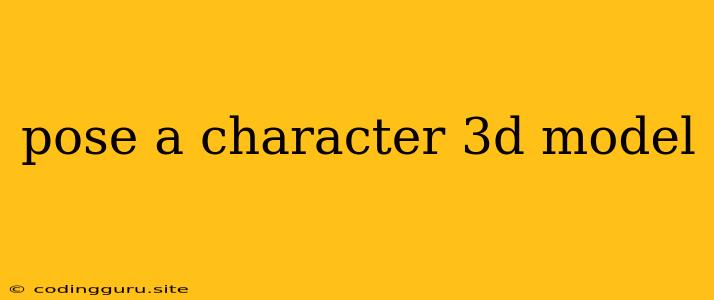Posing 3D Characters: Bringing Your Creations to Life
Creating a 3D model is a fantastic achievement, but it truly comes alive when you pose it! Posing adds personality, emotion, and dynamism to your characters, transforming static models into engaging stories.
Why is Posing Important?
- Communication: A well-posed character conveys a clear message, whether it's action, emotion, or a specific mood.
- Engagement: Dynamic poses grab the viewer's attention and draw them into the scene.
- Storytelling: Posing helps tell a story visually, adding depth and context to your character's role in a scene.
Understanding the Basics of Posing
- Reference: Before you start, study reference images or videos. Observe real people or characters that embody the pose you want to achieve. Pay attention to how their body interacts with gravity and space.
- Skeleton: Familiarize yourself with your 3D software's skeleton structure. Understand the different bones, joints, and how they move.
- Weight Transfer: The weight of a character should be distributed realistically. If they're leaning forward, their weight shifts to their front leg.
- Balance: Ensure your pose is balanced, so it doesn't look unnatural.
Tools for Posing
- Transform Tools: Use your software's rotation, translation, and scaling tools to adjust your character's limbs and body.
- Constraints: Limit the movement of certain bones for more natural poses.
- Pose Library: Many software packages offer built-in pose libraries for inspiration and quick starting points.
- IK (Inverse Kinematics): This tool allows you to move an end point (like a hand) and the program automatically adjusts the bones to reach that position. IK can be especially useful for complex poses.
- Scripts: Advanced users may write scripts to automate certain posing tasks or create complex animations.
Tips for Effective Posing
- Start with a Simple T-Pose: Use a basic standing pose as a starting point for easier manipulation.
- Use Reference Images: Look at reference images for inspiration, but don't copy them directly. Adapt the ideas to fit your character's style.
- Think Dynamically: Aim for poses that convey movement and energy. Don't be afraid to experiment!
- Focus on the Eyes: The eyes are crucial for conveying emotion. Direct the character's gaze to create a connection with the viewer.
- Don't Overdo It: Too many complex poses can look unnatural. Keep it simple and realistic.
- Practice Makes Perfect: Posing is a skill that improves with practice. Keep experimenting and pushing your creative boundaries.
Examples of Dynamic Poses
- Action Poses: A character striking a powerful pose during a fight, running, jumping, or throwing a punch.
- Emotional Poses: A character expressing sadness, joy, anger, or fear.
- Relaxed Poses: A character leaning back in a chair, casually sitting on a bench, or walking with a relaxed gait.
Posing for Specific Genres
- Game Characters: Consider how the pose will translate to gameplay. Does it enhance the character's role in the game?
- Animation: Dynamic poses are essential for animation, as they form the basis for keyframes.
- Film and TV: Character poses should be believable and enhance the visual storytelling.
Conclusion
Posing your 3D characters is a fundamental step towards bringing them to life. With practice and understanding, you can transform your creations into engaging and expressive figures. Remember to experiment, embrace your creativity, and find what works best for your specific projects.
